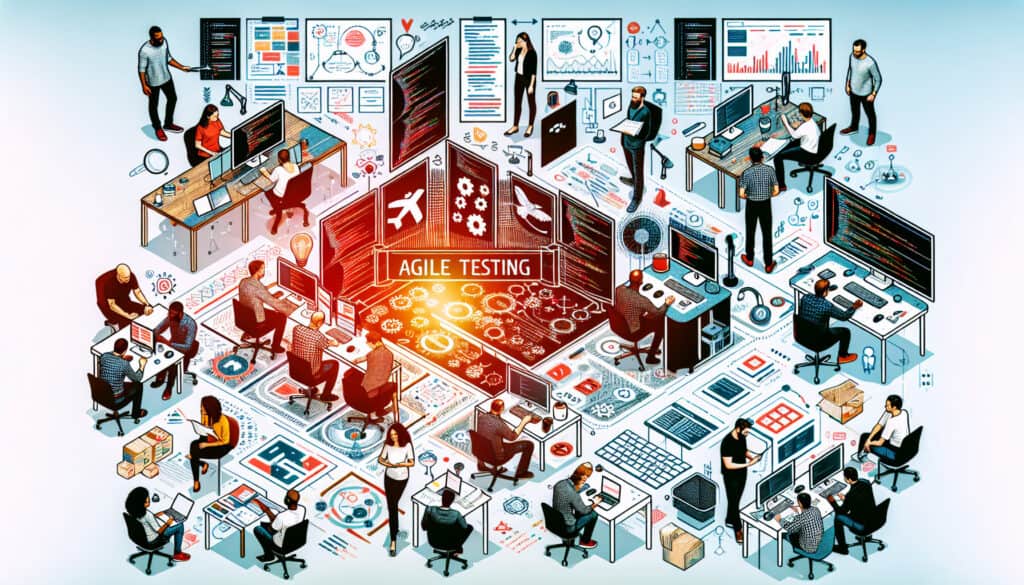A software testing practice that follows the principles of agile software development.
- Methodologies: Lean Sigma, Manufacturing
Agile Testing

Agile Testing
- Agile Methodology, Agile Product Development, Continuous Improvement, Quality Assurance, Quality Control, Quality Management, Scrum, Software Testing, Testing Methods
Objective:
How it’s used:
- In agile testing, testing is not a separate phase but is integrated into the development process. Testers work closely with developers to ensure that quality is built into the product from the beginning.
Pros
- Improves software quality, reduces the risk of defects, and allows for faster delivery of working software.
Cons
- Can be challenging to implement in traditional testing teams, requires a close collaboration between testers and developers, and may not be suitable for all types of projects.
Categories:
- Product Design, Project Management, Quality
Best for:
- Ensuring the quality of software in an agile development environment.
Agile Testing is particularly beneficial in industries where rapid changes in requirements demand increased adaptability, such as software development, e-commerce, financial services, and healthcare. In these sectors, Agile Testing supports Continuous Integration and Continuous Deployment (CI/CD) practices, ensuring that testing occurs simultaneously with development. During iterations or sprints, cross-functional teams—including developers, testers, and product owners—participate in collaborative sessions like sprint planning and daily stand-ups, facilitating timely feedback and iterative improvements. Agile Testing methodologies embrace various testing techniques, including unit testing, integration testing, and user acceptance testing, which allow teams to detect defects early when they are less costly to fix. This iterative approach minimizes the risk of significant failures in production, enhances team collaboration, and encourages a culture of accountability. Tools like automated testing frameworks and continuous testing platforms are commonly employed to enhance efficiency and provide quick feedback loops. Typical participants in this process not only include testers and developers but also stakeholders such as product managers and business analysts, who contribute to defining acceptance criteria and ensure alignment with user needs. In contexts where user experience is paramount, such as mobile application development, Agile Testing aids in ensuring that features are not only functional but also user-friendly and meet the intended design specifications before release.
Key steps of this methodology
- Define acceptance criteria collaboratively with stakeholders.
- Involve testers in sprint planning to understand user stories.
- Develop automated tests alongside application code.
- Execute tests continuously during the development process.
- Integrate testing into the continuous integration/continuous deployment pipeline.
- Perform exploratory testing during iterations for immediate feedback.
- Conduct regular code reviews that include testing considerations.
- Review and adapt testing strategies during retrospectives.
Pro Tips
- Implement Behavior-Driven Development (BDD) to create shared understanding among team members, enhancing collaboration between testers and developers.
- Utilize automated testing frameworks early in the sprint to allow for continuous integration and quick feedback loops on code changes.
- Incorporate exploratory testing sessions alongside scripted testing to uncover edge cases and enhance overall product robustness.
To read and compare several methodologies, we recommend the
> Extensive Methodologies Repository <
together with the 400+ other methodologies.
Your comments on this methodology or additional info are welcome on the comment section below ↓ , so as any engineering-related ideas or links.
Historical Context
1828
1850
1854
1854
1911
1928
1950
1827
1848
1850
1854
1895
1914
1943
1970
(if date is unknown or not relevant, e.g. "fluid mechanics", a rounded estimation of its notable emergence is provided)















Related Posts
Master Production Schedule (MPS)
Mass Customization
Marketing Funnel
Marketing Audit
MAPO Index (Movement and Assistance of Hospital Patients)
Manufacturing Resource Planning (MRP II)